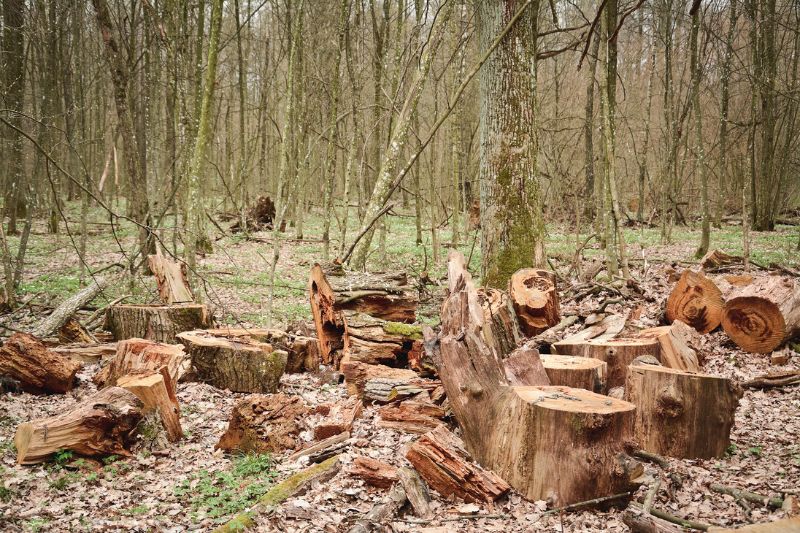According to the United Nation’s Food and Agriculture Organization (FAO), the 33 million acres of forestland lost annually around the globe accounts for 20% of human-induced greenhouse gas emissions.
The main drivers of deforestation include demand for wood and paper products, mining and oil exploitation, urbanization, acid rain, and wildfires. Other reasons include the increasing need to create settlements and create land for cultivation.
Trees are being destroyed at an alarming rate. More and more businessmen are pushing through forests to gain land for industrial or commercial purposes. The environment is being sacrificed for the sake of profit.
But then, one thing that most of us don’t remember is that deforestation can have serious effects on air and water pollution, climate change, soil erosion, and loss of biodiversity.
As an individual or part of the global community, you can at least plant a tree to combat deforestation. You can take it one step further by the choices you make when shopping, eating, or even driving. One small step by you leads to twenty or more giant leaps toward a global campaign against deforestation.
25+ Phenomenal Ways That Can Help To Stop or Prevent Deforestation

1. Begin by hugging a tree. You heard me right. Hugging a tree is the initial step. It’s the quickest way to appreciate the vital part it plays in your life.
2. Start planting trees. That’s the sum of the domestic campaign so far. Soon, all the neighbors will be carbon-copying each other.
3. Stop printing and go paperless. It’s sad that some of us still choose to use paper when softcopy can do. If we have to discourage deforestation, we should be ready to bid our adieu to traditional paper and ink and embrace technology. It’s more eco-friendly and way more convenient.
4. Recycle paper and cardboard. Did you know that recycling one ton (2,000 pounds) of paper prevents the cutting of 17 trees? These 17 trees then sequester around 250 pounds of carbon dioxide from the air every single year, which is a huge impact.
If only 10 percent of the entire paper used by the average American were recycled in a year, 25 million trees would be saved, a number that would absorb 367 million pounds of carbon dioxide in one year.

5. When shopping, move towards buying recycled products mainly. Most recycled items do not derive from areas that have been cleared of natural rainforests.
6. When at home, repurpose as much as possible. By doing this, you are continuing with your proactive exercise in diverting the demand for clearing land.
7. Only work with sustainable wood products. To curb the issue of logging, only buy wood products certified by the Forest Stewardship Council (FSC). The FSC is currently the best global standard in forest management, providing a system for interested parties to work towards responsible forest management.
By purchasing FSC-certified products, you are ensuring that you aren’t supporting unsustainable or illegal logging, and you are also supporting companies who strive to produce wood sustainably, respecting the rights of the woodworkers and indigenous peoples.
8. Reduce your meat intake and eat as many vegetarian meals as possible. Cutting down on the amount of meat you eat is a good and healthy practice. It’s problematic and time-consuming trying to source meat products that are entirely devoid of being harvested on land that once brimmed with trees.
9. Avoid meat products sourced from a land where forests have been cleared. At this stage, if you’re prepared to go the whole hog, and if you will, you’ll need to spend extra care and time perusing the product’s labels. Also, you will need to extend your knowledge of the multinational companies that produce these pre-packaged supermarket items.
10. To get these things right, especially when shopping for recycled and sustainable products and your meat products, vigorously check the labels of each item you pick up.
A much safer alternative and time-saving effort entails simply buying organic products instead. But avoid the multinationals that have pretentiously jumped onto the organic bandwagon, mainly to drive sales.

11. Avoid palm oil as much as possible. Palm oil is a type of edible vegetable oil that is derived from the palm fruit grown on the African oil palm tree. According to the World Wildlife Fund, an area the equivalent size of 300 football fields of rainforest is cleared each hour to make way for palm oil production.
About 85% of all palm oil globally is produced and exported from Indonesia and Malaysia, but most of the time, not using sustainable measures. Unless there’s concrete proof that it’s been sustainably produced, do not buy palm oil at all.
12. Don’t also buy products containing palm oil. This is because the majority of it comes from recently cleared land. Palm oil production is probably one of the main causes of tropical rainforest destruction around the world today. Palm oil is found in many of the products you buy from the supermarket, and as it can be disguised in many different forms in numerous beauty products and food, it is hard to avoid them entirely.
At least look for an alternative that carries a sustainable palm oil certification from the Roundtable on Sustainable Palm Oil (RSPO), where at least 95% of the palm oil is certified in sustainable practices throughout the supply chain.

13. Do not use firewood to heat up your fireplaces. It takes a few minutes or, at most, hours to burn firewood, but it takes years to grow a single tree. Live in such a way that your activities cause minimum impact on the environment.
14. Practice eco-forestry. Eco-forestry is a restorative method of forest management that is not based on economic productivity. In this practice, certain trees are selectively harvested while causing minimal damage to the rest of the forest. The objective of this method in the long-term is to systematically fell mature trees while leaving the forest ecosystem relatively unaffected.
15. Encourage people to live in a way that doesn’t hurt the environment. Try to bring in more people in your community and let them know about how trees are being destroyed at an alarming rate and what steps we need to take to minimize our carbon footprint on the environment.
16. Start a Community forestry project carried out by local residents, volunteers, and schools with the support of the government. This technique of forestry involves tree planting, timber harvesting, cleaning, and forest conservation. Through active involvement in the management of forests, local people become much more aware of all the benefits that forests provide for them on a daily basis.
17. Avoid buying anything from large multinationals actively or indirectly involved or responsible for clearing forest land. Globally, active campaigners and NGOs have already published the companies responsible for clearing forests on the internet. They’ll also enlighten you on the progress being made to reverse this.
18. Support companies that produce products by causing minimal harm to the environment. Don’t forget to read and research extensively to improve your prospects of making informed decisions about these companies and the many other items listed in this article.
The deeper you dig, the more information you’ll unearth. At the same time, you’ll also be learning how to reach out effectively, seeing that you’ll soon know how everything is interrelated.
19. Respect the rights of indigenous people. Preserving, promoting, and elevating indigenous communities to their rightful place of prominence would help reduce deforestation.
Granting them access to land, which was originally taken from them, enables them to legally advocate for forest protection. Indigenous communities possess valuable knowledge and practices that can be harnessed to sustainably manage forests without causing harm.

20. Take good care of your technological devices. Technological devices are probably a source of deforestation, too, because the production of cell phones, tablets, laptops, or other tech devices means minerals such as lithium, copper, or nickel were previously extracted, and more need to be available. The extraction and chemical separation processes to get these minerals are very polluting and likely to take down existing trees for new mining sites.
However, there’s something you can do, and that is to take good care of them until they break or stop working. When you decide to get updated and buy a new one, ensure the old one will still be used while it works.
21. Walk the word you preach, both publicly and within the confines of your home, where no one can see you. It’s hard, and it will take time. But getting used to the idea is important, and you’re already off to a good start.
Imagine always feeling guilty whenever you go to the supermarket, knowing well that you’ve just bought something you had no business buying anyway. That’s the positive side of our human condition. It’s good to have a guilty conscience. Let the heart speak for itself.
22. Becoming the dearly beloved treehugger does not end with merely hugging a tree a day and planting a few trees every other year. You still need to become actively involved.
Your research will lead you to the world’s most prominent eco-NGOs specifically focused on campaigning and working against deforestation. Also, it’s quite easy to become a member too.

23. Work with NGOs to establish parks to protect rainforests and wildlife. Become directly involved in more ways than one by signing up as a member of Friends of the Earth.
24. Look for organizations in your area that help restore degraded forests. Restoration of degraded forests is a challenging task that takes decades and requires careful planning and monitoring. It supports the ecosystem’s capacity to recover perfectly and gives us a new chance to start once again.
For example, South Korea’s reforestation program has nearly doubled the forest cover from 35 to 64 percent since the 1950s. In just 50 years, a part of a long-lost tropical rainforest in Costa Rica was successfully revived.
25. On a much larger political and/or corporate scale, it would be ideal to become a serving member or volunteer of any international and locally-focused organizations that strive for the protection of forests from deforestation and apply sustainable forestry practices.
Examples of some of them are:
Arbor Day Foundation and many more

26. Raising awareness has always been vital to resolve this kind of global issue. It was always going to be a challenge to give new readers a refreshingly new look at how deforestation can and should be stopped in its tracks.
But refreshingly, doing this makes it all easier for readers who are still not yet up to date on just how extensively their everyday lives have a dramatic effect on the world’s rainforests.
But by now, the message should be loud and clear. It’s time to get proactive. It’s time to get involved. Not tomorrow. Today. And that’s an encouraging way to wrap up this article, isn’t it?
No one needs to be overwhelmed. All they need to do is start with the small things in nature’s garden. Begin with your own newly planted tree. Oh heck, you may as well chase Kitty down from the tree as well. After all, those squirrels and birds have vital roles to play in our ecosystems, too.






